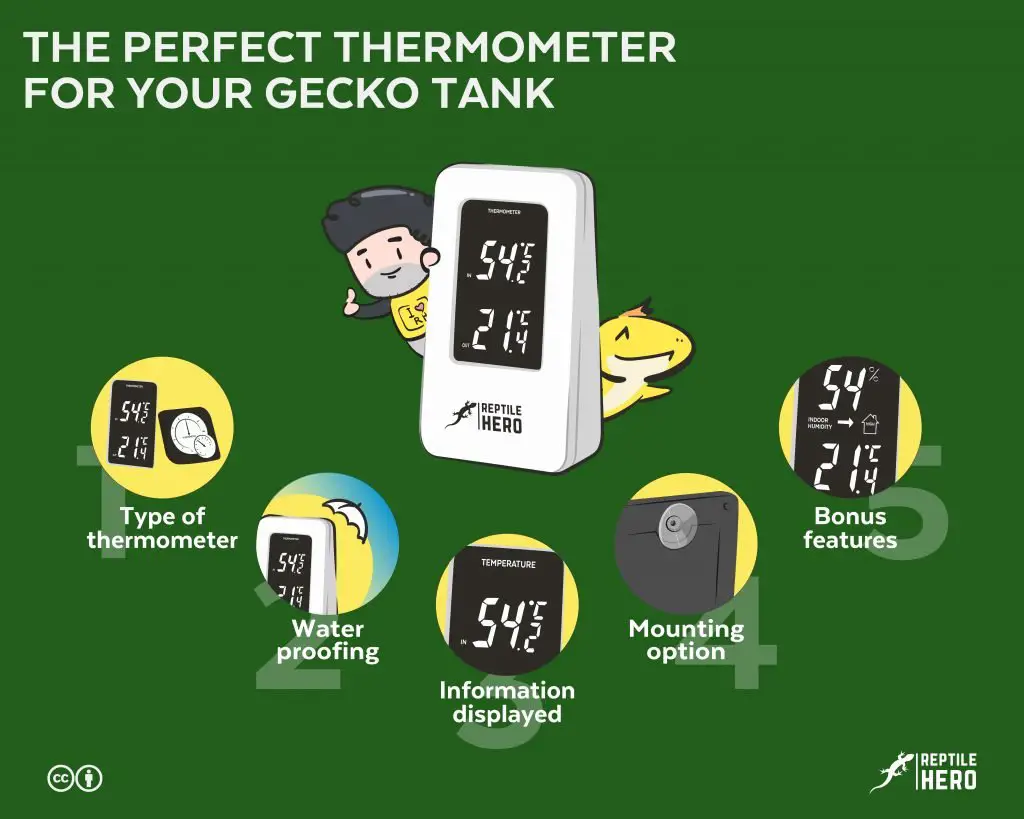The Perfect Thermometer for Your Gecko Tank (5 Crucial Factors to Check)
Does a perfect thermometer for gecko tanks actually exist? The answer is: YES! However, before buying one you need to learn about what to look at. Spoiler alert: the most expensive item is not always what you need. Rather, you should check 5 important factors and understand how they related to your gecko and its tank.
In general, to choose the ideal thermometer for a gecko tank it is necessary to consider the following features:
- Thermometer type
- Waterproofing
- Information displayed
- Mounting options
- Optional bonus features
Did you know that your thermometers and probes should be placed in the shade? If not, well now you do! Continue reading until the end to find out the reason behind this.
But if you’re short on time, you could skip straight to our recommended list of the best thermometers for gecko tanks—and other reptiles.
5 Factors to Look for in a Thermometer for Gecko Tanks
With all the options that get thrown at us online and offline, it can be confusing to get the right thermometer for our gecko tanks. Seemingly great products with mixed reviews sure don’t help either.
There’s also the problem with how certain types of thermometers marketed toward reptile enthusiasts aren’t really suitable for their set-ups. So continue reading below to find out how you could get the best thermometer for your gecko tank!

1. Thermometer Type
Overall, electronic (digital) types are the most recommended for use as permanent ambient thermometers in gecko tanks. However, bimetallic (analog) and liquid thermometers are also viable temporary and permanent options.
There are a variety of thermometers that are used in different fields. In the reptile community, there are two main kinds of thermometers that you need. First is an infrared thermometer. The second is an ambient thermometer.
This time around, our focus will be on ambient thermometers. All three of the common ones.
Below are the 3 types of ambient thermometers that can be used in gecko tanks [1]:
- Liquid
- Bimetallic
- Electronic
1. Liquid Thermometer
Not familiar with liquid thermometers? Then maybe mercury thermometers will help jog your memory.
How do liquid thermometers work?
You can tell the temperature based on the movement of the liquid inside the thermometer. The colored liquid will move up (expand) and down (contract) in direct response to changes in temperature. Indication numbers are printed on one or both sides, along a specified scale.
The 3 main drawbacks of liquid thermometers for gecko tanks are being a) possible hazards, b) fragile, and c) often hard to read.
Possible Hazard: Nowadays, liquid thermometers typically contain dyed alcohol instead of mercury due to the inherent dangers they pose once broken. Still, a gecko could ingest the alcohol inside if the liquid thermometer breaks or gets splashed in the eyes. Either way, it won’t be a fun experience for your cold-bellied pet.
Fragile Build: Moreover, there’s still a risk of broken glass with liquid thermometers. So keep that in mind. Especially if you have a gecko with really sticky feet. Geckos may knock a glass liquid thermometer out of place and get injured by broken glass shards.
Small Digits: Another drawback in using liquid thermometers is that they can be difficult to read because of the small numbers printed on their scale. It can be even harder to determine the temperature when it is placed inside a gecko’s tank—and even more so if you have bad eyesight.

Final Thoughts: For these reasons, liquid thermometers are rarely used within the reptile-keeping community. However, if you have one on hand and still can’t get a new one for your pets, it will do the job. They will also come in handy in cases of emergency since they don’t require batteries!
2. Bimetallic Thermometer
Bimetallic thermometers are commonly referred to as analog thermometers by reptile keepers and breeders. Just like liquid thermometers, the bimetallic thermometer does not require any external power source for it to work. Instead, it is powered by simple physics!
How do bimetallic, dial, or analog thermometers work?
Inside a dial thermometer, you will find a thin bimetallic strip that is either coiled or corkscrewed. This strip consists of two different metals that tend to behave differently when exposed to heat. When there is a temperature change, this strip will curl accordingly. The dial pointer will go up or down the scale to indicate the temperature.
The 2 main drawbacks of bimetallic thermometers for gecko tanks are a) slow response rates and b) the need for recalibration.
Slow Response Time: Although some keepers and breeders brush off dial thermometers for their supposed inaccuracy, this actually isn’t the case. In reality, analog thermometers are simply much slower to react to changes in temperature compared to digital types.
Requires Calibration: However, it seems that a lot of cheap options available online aren’t properly calibrated before shipping. This results in inaccurate readings unless recalibration is done properly. So expect to see a lot of negative reviews for this type of thermometer.
Final Thoughts: On the bright side, bimetallic thermometers will continue working flawlessly until it gets destroyed from getting dropped or mishandled. The scale on the face of this thermometer is normally color-coded too for quick and easy temperature reading. For these reasons, they are perfect backup thermometers.
3. Electronic Thermometer
Lastly, we have electronic or digital thermometers. These are preferred by most gecko keepers and breeders.
How do electronic or digital thermometers work?
Digital thermometers either have internal sensors or external probes. These components gauge temperature changes that are then relayed back to the main unit of the thermometer for processing. Finally, all pertinent information is displayed on the thermometer’s display screen.
The 3 main drawbacks of electronic thermometers for gecko tanks are that a) batteries are required, b) it is incompatible with water, and may have c )messy cords.
Battery Life: For electronic thermometers to work, you need a battery or two. Fortunately, batteries are commonly included with each unit you buy and last for at least 6 months. But you will still need to have a stock of replacement batteries in case it runs out of juice. In comparison, to the previous two types, this will cost you more in the long run.
Set-Up Compatibility: Another downside is that the electronic components inside digital thermometers are not compatible with highly humid gecko tank setups. Think tropical species—crested and day geckos. That is unless they are housed in a waterproof casing. (More on this in the next section.)
Probe Cords: The corded probes in some models can be a problem in terms of safety as your gecko may get entangled in it. However, proper installation will prevent this. Plus, the long cords of some digital thermometers will allow you to mount the main unit outside the tank, out of your curious gecko’s reach.
Learn more about how to choose a thermostat or our best thermostat
Final Thoughts: All things considered, electronic thermometers are the best choice because 1) they respond to temperature changes within a few seconds, 2) their information displays are easy to read and understand, 3) they have multiple mounting options, and 4) they often offer several bonus features.
2. Waterproofing
The ambient thermometer for gecko tanks should ideally have an ingress protection (IP) rating of at least IPX3. If that is not specified, look for its operating humidity. This ensures that the internal components will be safe in the event of accidental misting and it can be used for a variety of set-ups—from arid to tropical.
More specifically, an IPX3 rating will mean that your gecko tank’s thermostat can handle being directly sprayed at an angle of about 60º from the sides. In short, condensation and misting won’t break it.
Sadly, not all manufacturers are transparent about this. Some even claim that their products are “totally waterproof” without actual proof or appropriate testing. Keep your eyes peeled for those marketing tactics.
Frankly, this standard is more applicable for digital thermometers. However, you should also keep in mind how your liquid or analog thermometers will fare in a humid tank environment.
A liquid thermometer may read lower temperatures due to water buildup around it. Water may also seep through the lens of an analog thermometer and accumulate there.
Is it okay to directly mist the thermometer in a gecko tank?
Unless the thermometer in a gecko tank is completely waterproof or has a specified IP rating, misting directly onto it is generally not advised. Then again, liquid and bimetallic thermometers better tolerate water than electronic thermometers. Regardless, misting directly at thermometers may cause it to read water temperature instead of the air temperature.
3. Information Display
Generally, electronic thermometers that have bigger displays are recommended for easy reading. Conversely, liquid and bimetallic thermometers have small basic displays. As a result, it may be difficult to immediately determine the temperature.
For this section, a good analogy would be a clock. Do you prefer the old-fashioned analog? Or do you like the stylish digital design better?
The Basic Displays
The average alcohol and dial thermometers have scales that are traditionally printed or painted on the sides or in a circle. You can find models that have both Celsius and Fahrenheit or whichever you prefer individually. So there may be a bit of confusion when reading the gauge.
Additionally, such scales may be in a single color or color-coded accordingly. Blue shades correspond to low temps. Red is for high temps.
Because of their simplicity, it is easy to make them blend into their surroundings. You won’t have to worry about liquid and analog thermometers sticking out like a sore thumb in your immaculately designed vivarium.
On the other hand, though, small units also equate to small prints. So you would have to really come in close and focus on the thermometer to figure out the temperature reading.
The Modern Displays
Old and smaller versions of electronic thermometers have a very straightforward display screen, containing only their exact reading of ambient temperature. These figures are very specific to a decimal point or two—31.6ºC or 88.88ºF.
Nowadays, models provide both Celsius and Fahrenheit scales. You only need to choose which scale you prefer in the display. I have also seen some with backlit LCD screens so you can easily tell the temperature in your gecko tanks without any problem even in the dark.
Updated electronic thermometers may also have additional indispensable data displayed if it offers other functions.
4. Mounting Options
Thermometers with adhesive tapes are convenient for hassle-free mounting in gecko tanks. Unfortunately, they have caused serious injuries in different reptiles. Safer mounting options include the use of suction cups, hooks, holes, magnets, and stands.
More often than not, thermometers catered toward reptile keepers and breeders can be mounted in a gecko tank with strong adhesive tapes. This is commonly done to ensure that the thermometer stays where you initially stick it to.
However, I have come across more and more cases of these falling off vivarium walls and sticking to the delicate skin and scales of our lovely reptiles. There have been similar cases with velcro strips too.
A Real Case: The Silicone Solution for a Strangely Sticky Situation
In one specific case, I saw a snake that had a stick-on analog clock stuck to its lower jaw. The injury was so bad that it had stitches along the entire length of its jaw! Poor little danger noodle.
So rather than using these readily available mounting options, you could instead use some silicone to secure the thermometer in your gecko’s tank. This is a much safer alternative for those adhesives.
Pro Tip: Never place ambient thermometers and/or probes directly under a heat lamp (e.g., halogen, deep heat projector). Doing so will result in your thermometer gauging its sensor or probe’s surface temperature instead of your gecko tank’s ambient temperature.
Easy DIY Thermometer Probe Housing for Accurate Temperature Reading
To keep corded probes in the shade and ensure that they are reading ambient temperatures correctly, you can insert them into small tubes that are glued to the underside of a small flat piece of slate (here on Amazon). In doing so, you are anchoring the cord as well.
5. Bonus Features
Bonus features are not essential for gecko tank thermometers, but they provide more functionality. So gecko owners on a tight budget can just opt for simpler models with only the extra hygrometer function.
Numerous companies that produce tools and supplies for reptile-keeping offer feature-packed thermometers these days. However, most of these can only be found in electronic thermometers.
The most 6 common bonus features for gecko tank thermometers are:
- Hygrometer
- Time and Date
- Connectivity
- Data Processing
- Alerts
- Main Hub
Note: These additional features can raise the price of the thermometer quite a bit.
1. Hygrometer
This device works complementary to thermometers as it determines the humidity within the gecko tank.
However, many cheap thermo-hygro doubles have faulty hygrometers with inaccurate scales. By inaccurate, the measures are equally divided along the scale which shouldn’t be the case. This is particularly true for dual thermo-hygro analog gauges.
2. Time and Date
These details are especially helpful for gecko parents that make it a habit to keep track of their gecko’s environment and overall well-being.
3. Connectivity
Newer models provide Bluetooth and/or WiFi connectivity. These enable gecko owners to check on their geckos’ tank conditions without having to physically check on their tanks.
You can check on all your geckos using a mobile application when not at home and potentially set alarms.
4. Data Processing
As mentioned previously, the data collected by the thermometers may be collected and processed by the thermometer.
Such data include the highs and lows within a certain period. For instance, regular electronic thermometers can store and display the lowest and highest temperatures it has recorded within 24 hours.
Other smart models (here on Amazon) can collect months’ or years’ worth of data and even arrange it into a graph for easier analysis. This will be great for monitoring normal and abnormal changes in temperature which can greatly affect reptile behavior and well-being.
5. Alerts
This feature is especially helpful in guaranteeing that you have a backup plan in case your thermostat malfunctions and overheats or stops working altogether.
You can set it to either sound out an alarm or send a notification to your phone through the app when temperatures drop below or go beyond a specified range.
6. Main Hub
Smart wireless digital thermometers (here is an example of a good one on Amazon) come as a package with multiple sensors and a single main hub—sometimes called the gateway. This allows gecko parents to check on multiple tanks with a single app.
However, the gateway will need to be plugged into a power outlet, or a power bank during an emergency. Plus, each sensor commonly has no information display and requires its own batteries. So such an investment isn’t recommended for beginners.
Further Questions
Are thermometers and thermometer guns the same thing?
Regular tank thermometers and thermometer guns are two different equipment used in the reptile-keeping community. A thermometer is designed to measure ambient or air temperature, making it best for determining thermal gradients within a gecko tank. In comparison, temp guns detect surface temperatures, making them perfect for checking basking spots.
Do you still need a thermometer if you already have a thermostat for your gecko tank?
Yes, you still need a thermometer for each of your gecko tanks even if you already have a thermostat. The reason is they have different but complementary functions. A thermometer is for monitoring the thermal gradient within the tank, whereas the thermostat is used to control the heating and/or cooling devices used in the enclosures.
How many thermometers do you need in a gecko tank?
Ideally, one gecko tank should have at least two separate thermometers. One to monitor the low end of the thermal gradient, the other for the high end. However, some owners add more for much larger or longer tanks as the temperature is more likely to vary in such enclosures.
Where should you place your thermometer?
Place your thermometer and/or probes around the areas your gecko utilizes a lot. For terrestrial species, the thermometer should be near the substrate or ground. Add extra ones higher up on the tank walls if the gecko likes to explore around there. Arboreal species need at least 2 thermometers along the entire height of their typically tall tanks.
Summary of the Perfect Thermometer for Gecko Tanks
Not all thermometers can be used to reliably and accurately measure the temperature and thermal gradient within gecko tanks. Many factors must be taken into consideration before reptile owners buy one for their pets: type, waterproofing, display, mounting options, and bonus features of the thermometer.
Keepers and breeders do not need to look for reptile-specific thermometers. Many regular digital thermometers from reputable companies nowadays can withstand the environmental requirements of several commonly kept gecko species.


![Do Leopard Geckos Need Heat Mats? [Myth or Truth]](https://www.reptilehero.com/wp-content/uploads/2022/03/does-gecko-needs-heat-mats-cc-768x614.jpg)

![4 Reasons Why Leopard Geckos Get Neutered [and Problems]](https://www.reptilehero.com/wp-content/uploads/2021/04/Can-Gecko-Get-Neutered-768x614.jpg)
![Does a Leopard Gecko Really Need a Heat Lamp? [Final Guide]](https://www.reptilehero.com/wp-content/uploads/2022/03/Do-geckos-need-heat-lamp-cc-768x614.jpg)

